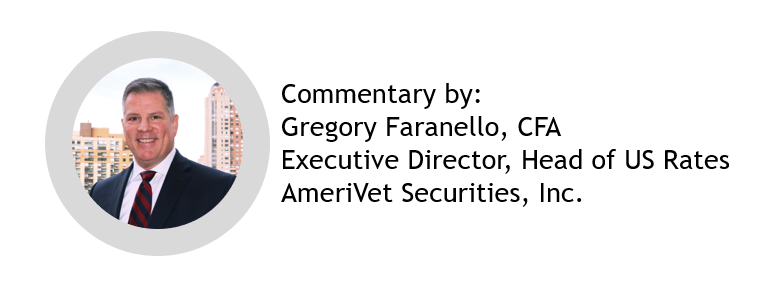S&P- Watch October 2019
In the US, the ISM manufacturing data rebounded this week and China continues to combat what will be a likely short term shock to an already delicate economy.
So much so, they have already asked the United States for a short term reprieve on the Phase 1 trade deal.
Suffice it to say, no one had this on their radar screen and most plans and predictions for 2020 scrapped or adjusted for now. It’s a long year but dealing with the issue at hand is paramount to governments and markets around the globe.
We think it will be very tough for the global economy outside the US to rebound without China. Certainly recent history tells us this will be the case.
The US Funds Rate
What does this mean for Fed policy?
Short term likely nothing so long as the data holds up. And certainly the payroll number does little to change that.
Fed’s challenge in a chart below: China. Last year “tariffs”, 2020 Coronavirus.
Yellow: Yuan
White: Negative Asset Pool
Green: 30-year UST
Purple: 5-year Forward, 5-year Inflation Expectations
Follow the Yuan and the price action. Weaker Yuan, higher negative asset pool and vice versa. The ups and downs of the Chinese economy have driven the global economic story outside the US. And the difference between the Effective Funds Rate trading at 1.59 versus zero has been the US consumer. Plain and simple.
Christine LaGarde recently indicated the European Central Bank’s review on negative interest rate policies will be done at the END of 2020. The Swiss National Bank is all-in with recent comments. The negative yield story continues to spill over into the United States. And the search for yield (equity v credit/credit v equity) is real.
The negative yielding asset pool is up over 3 Trillion in a matter of weeks (Coronavirus). With negative nominal and real sovereign yields abroad, the US Treasury long end is a key, liquid hedge for the risk-off trade. We respect 1.50% as a level but context from 2016/2019 lends to a potential further move lower. In both cases China was a key factor.
Negative Yielding Asset Pool
Inflation expectations in the US recovered (2016-2018) with the perception of fiscal support. With one of the most contentious political seasons we’ve seen in the US ahead, and China once again in a precarious spot, talk of “uncertainty and risk management” may be close behind the Fed’s “material reassessment”. It’s too early to tell, but not too early to discuss.
US Forward 5-Year Inflation Expectations
It is fair to expect the PBOC and Chinese government to continue to offer the kitchen sink to protect the Chinese people and economy. What’s not clear this year unlike last, is how other central banks will react. The Fed included.
Yuan versus Negative Yielding Asset Pool
Short term, with regards to the Fed, we have seen a slight uptick in Fed probabilities for potential 2020 easing. And in general the curve has been in flattening mode with the move down to 1.50/2.00% in 10 and 30-year yields. This has been largely in line with our expectations for a directional curve.
We think it makes sense to watch the data closely here. And really for the most part, there has been nothing of late to sound alarm bells.
In some ways, this year sets up with similar dynamics then last. Uncertainty and China. The big difference, however, is after a full year of very strong global central bank liquidity in 2019, valuations are now at much different levels.
On the credit side, spreads and volatility have adjusted slightly, but the influx of issuance remains extremely strong and the demand for yield is still there.
CDS 5-Year Volatility Index (Credit)
This is a trade that feeds upon itself: negative rate policies, global slowdown and uncertainty (tariffs 2019/Coronavirus 2020) and the negative yielding asset pool growing again. The further negative, the more the demand and search for positive yield in both equity and fixed income. It behaves very much like a negative convexity trade.
We still favor a nimble and open mindset. And it remains unclear exactly where the virus is at, and the ultimate implication for the Chinese and global economy. Our gut is that this will act as a short term shock, and clearly with the potential for central banks outside China once again speaking about risk management and uncertainty. The bar will be higher this year than last. Yet, in some ways the “stakes” could be higher after a year of extreme liquidity and the efficacy of central bank effectiveness already in question at this point in the cycle.
The global economy is still very much in need of fiscal support. And with China battling the virus, the UK still in flux post-Brexit and Potus on the cusp of a year long political battle, all eyes will continue to remain on the US consumer and central banks as we continue to work through the impact of the Coronavirus.
A tale of different markets right now, but for how long? China is reacting very quickly to utilize short term liquidity measures to thwart the ongoing concern over the Coronovirus. In the end, we all want safety and containment. And as extreme measures continue to work through the global economy, the discussion quickly turns to growth.
To us, the concerning thing (economically) is an already strained situation in China that precedes the trade war with the United States. And our general view in looking at how the global economy has performed around China over the past 5 years: no global recovery without China.
For now, we expect volatility to continue to pick up. Short term, we will stay nimble, respect levels and the dynamics within this period of time. A continued move lower in 10-year rates from here would not be constructive for risk assets in our view.
With the Fed on hold for now, the dynamics will likely play out differently short term if the implication of Corovirus worsen but remain uncertain for the US growth story. There should be little doubt the Fed will act further (lower), if the growth and inflation story continues to language. And “material reassessment” becoming very relative.












